Convergence of Software-Defined Vehicular Cloud and 5G Enabling Technologies: A Survey
Abstract
1. Introduction
- Vehicle mobility: Replication and relocation of virtual machines (VMs) are combined to increase the quality of services (QoS) of cloud-based vehicular applications. The high mobility in VC influences the relocation of virtualized resources. In this situation, the SDN controller is in charge of VM migration and replication.
- Provisioning of computing resource: Information from VC providers and users is composed mainly of resource management, connectivity loss, and the decision rules from SDN application to SDN control layer. Based on those information, the management of VC resources are efficiently allocated to vehicles forming a cluster to compute intensive tasks [12].
- Heterogeneous wireless communication: The assistance of SDN applications in SDVC enables the control layer to generate forwarding rules on data plane switches regardless of the wireless communication modules deployed among vehicles of the VC cluster. Therefore, VC improved its ability to share computation tasks, cache (store) data, and provide reliable bandwidth.
- Privacy: Privacy modules running in SDN controllers would predict the privacy issue and then protect forwarding devices.
| SN | Parameters | VCC | SDVC |
|---|---|---|---|
| 1 | Computational Resource. |
|
|
| 2 | Architecture model [4]. |
|
|
| 3 | Monitoring actual resources. |
| VC controller collects:
|
| 4 | Optimization of VC operations. |
|
|
- Communication decisions are made closer to the VC with the help of the SDN control, which computes the network topology of the vehicle cluster. The cloud participates only when additional processing is required, hence significantly reducing latency and cost of (billing) of consumed resources;
- Vehicle privacy is enhanced because information about inter-vehicular communication plans and network topology required for running cooperative tasks by a cluster of vehicles are stored locally on the vehicles themselves rather than in the cloud;
- Self-organizing architecture of SD controllers provides more reliable computation of VC tasks;
- SDVC can promote the ubiquity of VC services and acknowledge the goal of “delivering massive computation resource to every vehicle user and every IoV systems everywhere” with the ability to process tasks of different sizes;
- Diverse and valuable VC services would increase the commercial value of SDVC infrastructure as a service and speed up its deployment and growth.
- The advancement of heterogeneous wireless communication in vehicles and the availability of diverse virtual network functions generate massive traffic data.
- At the same time, the VCC infrastructures are implementing cloud-native applications using the serverless and micro-services approach. The virtualization of physical networks creates logical instances tailored to handle customized VC services that require the use of management and orchestration platforms.
- Improving the reliability, the persistence of the connection between vehicle users and the cloud, and shared resources will require virtual network instances of SDVC that implement VC network slicing.
- NFV service chaining and decision learning based on ANN algorithms accurately optimize virtual network instances of SDVC inside NS systems. NFV service chaining is helpful for maintaining the QoS of instances when unexpected failures occur in a single VC network slicing.
- When confronted with complex and time-consuming vehicular cloud network information, VC can rely on ESDVC to create a platform as a service over VC network slicing to powerfully learn how to extract valuable information on the management and maintenance of SDVC.
| SN | Description | Causes | Consequences | Techniques |
|---|---|---|---|---|
| 1 | Vehicle mobility | Drive at high speeds |
|
|
| 2 | Provisioning of computing resource | VC lacks functions for:
|
|
|
| 3 | Privacy | Malicious nodes among VC cluster | Protect forwarding devices | Privacy modules running in SDN controllers would predict the privacy issue. |
| SN | Parameters | SDVC | ESDVC |
|---|---|---|---|
| 1 | Goal | Push knowledge of VC communication, VC formation, and VC resources to a remote controller server. | Integrate 5G and beyond technologies based on NFV (e.g., NS, VNF/CNF) into the SDVC. |
| 2 | Data plane |
|
|
| 3 | Control plane |
|
|
| 4 | Features and advantages |
|
|
- Cloud frameworks on SDVC, technical frameworks for systematically organizing 5G enabling technologies and SDN to provide efficient VC applications;
- NFV technology in SDVC, concentrating on the practical deployment, programmability, and management of SDVC to meet various requirements;
- Data plane for SDVC, in terms of virtual network functions, and hardware to assist 5G vehicle-to-everything (V2X) communication modes.
- We provide the architecture of vehicular-cloud and mobile edge vehicular cloud-based architecture and their architecture for VC systems.
- We summarize techniques or methods-based SDN to address VC challenges through the SDVC architecture.
- We discuss the idea behind the extended software-defined vehicular technologies. An architecture, paradigm-based 5G enabling technologies toward the ESDVC, is provided. We present a summary of comparison between SDVC and ESDVC.
- We discuss the architecture of a VC network slicing service as a use case of ESDVC.
- We discuss techniques and methods based on SDVC from the literature. These techniques are classified into three layers. The application layer concerns the cloud framework services on SDVC. The control layer concerns software-defined control systems. The data plane includes the data plane for IoV systems.
- We discuss lessons learned and open challenges for VC network slicing that leverages ESDVC.
| Ref | VN Challenges | SDN-Based VN | Focus of Discussion | ||||||
|---|---|---|---|---|---|---|---|---|---|
| Data Analytic | Energy and Resource Utilization | Network and Routing | Security | VM Migration | SDVN | 5G-SDVN | SDVC | ||
| [22] | {√} | {√} | SDVN components | ||||||
| [2] | {√} | {√} | MEC and virtualization | ||||||
| [23] | {√} | {√} | SDVN components | ||||||
| [24] | {√} | {√} | SDN applications | ||||||
| [25] | {√} | {√} | SDVN architecture | ||||||
| [26] | {√} | {√} | Advanced routing | ||||||
| [28] | {√} | {√} | Rational use of resources | ||||||
| [27] | {√} | {√} | SDN techniques | ||||||
| [29] | {√} | {√} | SDVN deployment | ||||||
| [30] | {√} | {√} | {√} | Big data pipelines | |||||
| [31] | {√} | {√} | {√} | End-to-end security | |||||
| [32] | {√} | {√} | Power model on IaaS | ||||||
| Ref | Focus of Survey Discussion |
|---|---|
| [22] | Technical advantages of cloud computing and SDN applied to vehicular networks |
| [2] | Ability of SDVC for managing migration scenarios of several virtual machines (VMs) |
| [23] | Comprehensive explanation of SDVN components, access technologies, and protocols |
| [24] | Impact of SDN paradigm along with implementation SDN applications in vehicular communication |
| [25] | SDVN architectures against major security threats and future 5G information-centric networking |
| [26] | Advanced routing schemes based on SDN and named data networks for VANETs and ITSs |
| [28] | Rational use of resources to enable the sustainable development of IoVs |
| [27] | SDN techniques tailored for VANET domain in terms of architecture and communications requirements |
| [29] | SDVN deployment in classic vehicular networks, 5G-VANETs, vehicular cloud, and vehicular fog |
| [30] | Comprehensive overview of big data and data analysis pipelines for smart 5G |
| [31] | Comprehensive framework for end-to-end security mechanisms in 5G-SDVN |
| [32] | Power models on IaaS for enabling VM migration |
| our survey | Techniques toward extended SDVC by leveraging 5G enabling technologies such as network slicing, MEC |
2. Fundamentals of Software-Defined Vehicular Cloud Computing
2.1. Models of Vehicular Cloud Computing
2.1.1. Road Side Unit and Road Side Unit-Aided Cluster Vehicular Cloud
2.1.2. Mobile Edge Vehicular Cloud
2.2. Software-Defined Network
2.3. Software-Defined Vehicular Cloud Network
- Collecting in-vehicle sensor information such as about speed, the surrounding nodes (e.g., adjacent vehicles, pedestrians on the roads, weather conditions), and the current position information.
- Exchanging vehicle supporting V2V application messages.
- Communication between the OpenFlow-based onboard unit and the SDN controller located at the edge of the network by leveraging a distributed MEC server placed to reduce network delay in processing sensed data, then improve routing protocols.
- Information collection module—provides global knowledge of the RSU or fog-assisted VC based on the data information from the data plane.
- Communication decision module—monitors the link status of the decision of using unicast or broadcast communication to vehicles clustered to one RSU or fog-assisted VC.
- Caching V2X messages module—saves the V2X application data at RSU or MEC-assisted VCs to reduce the transmission delay for V2X services.
- Network status module—monitors and queries the network state of the SDVC.
3. The Architecture of Extended Software-Defined Vehicular Cloud
3.1. 5G Enabling Technology for the Extended SDVC Framework
| Relevant SDN Controllers Assistance | Resource Sharing | ||||||
|---|---|---|---|---|---|---|---|
| Potential Application | SDN OpenFlow Controller | SDN Communication Infrastructure Controller | Active VM Controller | Computation | Storage | Bandwidth | Latency (ms) |
| Real-time traffic condition analysis and broadcast | √ | √ | √ | √ | √ | 10–100 [34] | |
| Video surveillance | √ | √ | √ | 120–200 [51] | |||
| Mobile social networking | √ | √ | √ | √ | √ | 10–100 [52] | |
| In-vehicle multimedia entertainment | √ | √ | √ | √ | √ | 10–100 [34] | |
| Remote vehicle diagnostics | √ | √ | √ | √ | 10–100 [34] | ||
| Location-based services recommendations based on personalized and precise service [53] | √ | √ | √ | √ | √ | 10–65 [53] | |
3.2. Extended SDVC for VC Network Slicing System
3.3. Architecture of ESDVC Compared to SDVC
4. Technologies in SVDC and ESDVC
4.1. Cloud Framework Services on SDVC
4.1.1. Vehicular Resource Utilization Services
4.1.2. Migration of Cloud Vehicular Resources
4.1.3. Security Mechanism
4.1.4. Serving Broker
4.1.5. IoV Network Measurement
4.1.6. Distributing Software Updates
| Framework | Ref | Architecture | Techniques | Computation Layer | Key Metrics |
|---|---|---|---|---|---|
| Vehicular resource utilization | [4] | SDVC |
| VC-based IaaS |
|
| [59] | SDVC |
| Fog computing servers |
| |
| [22] | Cloud-enabled SDVN | SDN controller manages resources | Cloudlet servers | Decision making for resource allocation. | |
| Migration of cloud vehicular resources | [2] | SDVC | VM migration | MEC | Update dynamically VC topology. |
| Security mechanism | [62] | SDVC | Security mechanism in the control plane | Trust third party |
|
| Service broker | [63] | SDVC-aided RSU |
| SDN broker application |
|
| IoV network measurement | [64] | IoV-based SDN |
| SDN controller |
|
| Distributing software updates | [13] | SDVC |
| Vehicle manufacturer cloud |
|
4.2. Software-Defined Control Technique in SDVC
4.2.1. Use Virtual Network Functions
4.2.2. Software-Defined Pseudonym System
4.2.3. Traffic and Connectivity Management
4.2.4. Network Reconfiguration
| Framework Services | Ref | Architecture | Techniques | Computation Layer | Key Metrics |
|---|---|---|---|---|---|
| Use Virtual network functions | [65] | ESDVC |
| Cloud-based server |
|
| Software-defined pseudonym system | [66] | SDVC |
| Cloud-based server |
|
| [67] | SDVC |
| NF slicing server |
| |
| [68] | SDVC |
| Authority server |
| |
| Traffic and connectivity management | [69] | SDVC | V2X techniques for road traffic conditions | V2X SDN controller. |
|
| [70] | SDVC |
| SDN controller-based RSU |
| |
| Network reconfiguration | [71] | SDVC |
| SDN RSU cloud |
|
| [72] | SDVC |
| SDN RSU cloud | Reduce computation delay. |
4.3. Data Plane for SDVC
Data Plane for IoV PLATFORM
5. Lessons Learned and Open Challenges
5.1. More Promising Techniques in VC Network Slicing
Evolve ESDVC with 6G
5.2. Open Challenges and Future Research Directions
5.2.1. Improvement of Key Performance Metrics
5.2.2. Generalization of VC Network Slicing Controller
5.2.3. Hybrid NFs for VC Network Slicing Reconfiguration
6. Conclusions
Author Contributions
Funding
Institutional Review Board Statement
Informed Consent Statement
Data Availability Statement
Acknowledgments
Conflicts of Interest
Abbreviations
| 5G | fifth generation |
| 5G URLLC | ultra-reliable low-latency communication |
| ANNs | artificial neural networks |
| BS | base station |
| CNFs | container network functions |
| C-RAN | cloud radio access network |
| DRL | deep reinforcement learning |
| eNB | evolved node base |
| ESDVC | extended SDVC |
| ETSI | European Telecommunications Standards Institute |
| FG | fog computing |
| IaaS | infrastructure-as-a-service |
| IoVs | Internet of vehicles |
| ITS | intelligent transportation system |
| MEC | multi-access edge computing |
| NFs | network functions |
| NFV | network function virtualization |
| NS | network slicing |
| QoS | quality of service |
| RP | resource providers |
| RSU | road side unit |
| SDN | software-defined network |
| SDVC | software-defined vehicular cloud |
| V2I | vehicle-to-infrastructure |
| V2V | vehicle-to-vehicle |
| V2X | vehicle-to-everything |
| VCC | vehicular cloud computing |
| VE | vehicle equipment |
| VMs | virtual machines |
| VNFs | virtual network functions |
| VPMN | virtual private mobile networks |
References
- Nkenyereye, L.; Jang, J.W. Lowering the Barriers of Cloud –based Vehicular Applications using Software Defined Network. In Proceedings of the 2018 International Conference on Information and Communication Technology Convergence (ICTC), Jeju, Republic of Korea, 17–19 October 2018; pp. 1119–1123. [Google Scholar] [CrossRef]
- Nkenyereye, L.; Nkenyereye, L.; Adhi Tama, B.; Reddy, A.G.; Song, J. Software-Defined Vehicular Cloud Networks: Architecture, Applications and Virtual Machine Migration. Sensors 2020, 20, 1092. [Google Scholar] [CrossRef] [PubMed]
- Olariu, S.; Eltoweissy, M.; Younis, M. Towards Autonomous Vehicular Clouds. ICST Trans. Mob. Commun. Appl. 2011, 11, e2. [Google Scholar] [CrossRef]
- Jang, I.; Choo, S.; Kim, M.; Pack, S.; Dan, G. The Software-Defined Vehicular Cloud: A New Level of Sharing the Road. IEEE Veh. Technol. Mag. 2017, 12, 78–88. [Google Scholar] [CrossRef]
- Xu, S.; Guo, C. Computation Offloading in a Cognitive Vehicular Networks with Vehicular Cloud Computing and Remote Cloud Computing. Sensors 2020, 20, 6820. [Google Scholar] [CrossRef] [PubMed]
- Khan, A.; Abolhasan, M.; Ni, W. 5G next generation VANETs using SDN and fog computing framework. In Proceedings of the 2018 15th IEEE Annual Consumer Communications & Networking Conference (CCNC), Las Vegas, NV, USA, 12–15 January 2018; pp. 1–6. [Google Scholar] [CrossRef]
- Huang, C.M.; Chiang, M.S.; Dao Duy, T.; Su, W.L.; Xu, S.; Zhou, H. V2V Data Offloading for Cellular Network based on the Software Defined Network (SDN) inside Mobile Edge Computing (MEC) Architecture. IEEE Access 2018, 6, 17741–17755. [Google Scholar] [CrossRef]
- He, Z.; Cao, J.; Liu, X. SDVN: Enabling rapid network innovation for heterogeneous vehicular communication. IEEE Netw. 2016, 30, 10–15. [Google Scholar] [CrossRef]
- Tang, Y.; Cheng, N.; Wu, W.; Wang, M.; Dai, Y.; Shen, X. Delay-Minimization Routing for Heterogeneous VANETs With Machine Learning Based Mobility Prediction. IEEE Trans. Veh. Technol. 2019, 68, 3967–3979. [Google Scholar] [CrossRef]
- Aujla, G.; Chaudhary, R.; Kumar, N.; Rodrigues, J.; Vinel, A. Data Offloading in 5G-Enabled Software-Defined Vehicular Networks: A Stackelberg-Game-Based Approach. IEEE Commun. Mag. 2017, 55, 100–108. [Google Scholar] [CrossRef]
- Dhawankar, P.; Raza, M.; Le-Minh, H.; Aslam, N. Software-Defined Approach for Communication in Autonomous Transportation Systems. EAI Endorsed Trans. Energy Web 2017, 4, 152924. [Google Scholar] [CrossRef]
- He, X.; Ren, Z.; Shi, C.; Fang, J. A novel load balancing strategy of software-defined cloud/fog networking in the Internet of Vehicles. China Commun. 2016, 13, 140–149. [Google Scholar] [CrossRef]
- Azizian, M.; Cherkaoui, S.; Senhaji Hafid, A. Vehicle Software Updates Distribution with SDN and Cloud Computing. IEEE Commun. Mag. 2017, 55, 74–79. [Google Scholar] [CrossRef]
- Sudheera, K.; Ma, M.; Chong, P. Link Stability Based Optimized Routing Framework for Software Defined Vehicular Networks. IEEE Trans. Veh. Technol. 2019, 68, 2934–2945. [Google Scholar] [CrossRef]
- Liu, J.; Wan, J.; Zeng, B.; Wang, Q.; Song, H.; Qiu, M. A Scalable and Quick-Response Software Defined Vehicular Network Assisted by Mobile Edge Computing. IEEE Commun. Mag. 2017, 55, 94–100. [Google Scholar] [CrossRef]
- Lai, C.F.; Chang, Y.C.; Chao, H.C.; Hossain, M.S.; Ghoneim, A. A Buffer-Aware QoS Streaming Approach for SDN-Enabled 5G Vehicular Networks. IEEE Commun. Mag. 2017, 55, 68–73. [Google Scholar] [CrossRef]
- Qi, W.; Song, Q.; Wang, X.; Guo, L.; Ning, Z. SDN-Enabled Social-Aware Clustering in 5G-VANET Systems. IEEE Access 2018, 6, 28213–28224. [Google Scholar] [CrossRef]
- Waheed, A.; Shah, M.A.; Mohsin, S.M.; Khan, A.; Maple, C.; Aslam, S.; Shamshirband, S. A Comprehensive Review of Computing Paradigms, Enabling Computation Offloading and Task Execution in Vehicular Networks. IEEE Access 2022, 10, 3580–3600. [Google Scholar] [CrossRef]
- Correia, S.; Boukerche, A.; Meneguette, R. An Architecture for Hierarchical Software-Defined Vehicular Networks. IEEE Commun. Mag. 2017, 55, 80–86. [Google Scholar] [CrossRef]
- Campolo, C.; Molinaro, A.; Iera, A.; Menichella, F. 5G Network Slicing for Vehicle-to-Everything Services. IEEE Wirel. Commun. 2017, 24, 38–45. [Google Scholar] [CrossRef]
- Skondras, E.; Michalas, A.; Vergados, D.J.; Michailidis, E.T.; Miridakis, N.I.; Vergados, D.D. Network Slicing on 5G Vehicular Cloud Computing Systems. Electronics 2021, 10, 1474. [Google Scholar] [CrossRef]
- Wang, Q.; Gao, D.; Zhu, W. Cloud-enabled Software-Defined Vehicular Networks: Architecture, Applications and Challenges. J. Internet Technol. 2019, 20, 1819–1828. [Google Scholar]
- Bhatia, J.; Modi, Y.; Tanwar, S.; Bhavsar, M.D. Software defined vehicular networks: A comprehensive review. Int. J. Commun. Syst. 2019, 32, e4005. [Google Scholar] [CrossRef]
- Chahal, M.; Harit, S.; Mishra, K.; Sangaiah, A.; Zheng, Z. A Survey on software-defined networking in vehicular ad hoc networks: Challenges, applications and use cases. Sustain. Cities Soc. 2017, 35, 830–840. [Google Scholar] [CrossRef]
- Ben Jaballah, W.; Conti, M.; Lal, C. A Survey on Software-Defined VANETs: Benefits, Challenges, and Future Directions. arXiv 2019, arXiv:1904.04577. [Google Scholar]
- Khan, H.U.; Wahid, I.; Tanvir, S.; Hameed, A.; Ahmad, M. Software-Defined Networks and Named Data Networks in Vehicular Ad Hoc Network Routing: Comparative Study and Future Directions. Secur. Commun. Netw. 2022, 2022, 1270180. [Google Scholar]
- Cardona, N.; Coronado, E.; Latré, S.; Riggio, R.; Marquez-Barja, J.M. Software-Defined Vehicular Networking: Opportunities and Challenges. IEEE Access 2020, 8, 219971–219995. [Google Scholar] [CrossRef]
- Chen, H.; Zhao, T.; Li, C.; Guo, Y. Green Internet of Vehicles: Architecture, Enabling Technologies, and Applications. IEEE Access 2019, 7, 179185–179198. [Google Scholar] [CrossRef]
- Mekki, T.; Jabri, I.; Rachedi, A.; Fourati, L. Software-defined networking in vehicular networks: A survey. Trans. Emerg. Telecommun. Technol. 2021, 33, e4265. [Google Scholar] [CrossRef]
- Alhilal, A.Y.; Finley, B.; Braud, T.; Su, D.; Hui, P. Street Smart in 5G: Vehicular Applications, Communication, and Computing. IEEE Access 2022, 10, 105631–105656. [Google Scholar] [CrossRef]
- Garg, S.; Kaur, K.; Kaddoum, G.; Ahmed, S.H.; Jayakody, D.N.K. SDN-Based Secure and Privacy-Preserving Scheme for Vehicular Networks: A 5G Perspective. IEEE Trans. Veh. Technol. 2019, 68, 8421–8434. [Google Scholar] [CrossRef]
- Jena, S.; Vijayaraja, V.; Sahu, A.K. Performance Evaluation of Energy Efficient Power Models for Digital Cloud. Indian J. Sci. Technol. 2016, 9, 1–7. [Google Scholar] [CrossRef]
- Zhang, Y.; Gjessing, S.; Xia, W.; Yang, K. Toward Cloud-Based Vehicular Networks with Efficient Resource Management. Netw. IEEE 2013, 27, 48–55. [Google Scholar] [CrossRef]
- Sutton, G.; Zeng, J.; Liu, R.; Ni, W.; Nguyen, D.; Jayawickrama, B.; Huang, X.; Abolhasan, M.; Zhang, Z.; Dutkiewicz, E.; et al. Enabling Technologies for Ultra-Reliable and Low Latency Communications: From PHY and MAC Layer Perspectives. IEEE Commun. Surv. Tutor. 2019, 21, 2488–2524. [Google Scholar] [CrossRef]
- Ben bezziane, M.; Korichi, A.; Kerrache, C.A.; Fekair, M.e.A. RCVC: RSU-Aided Cluster-Based Vehicular Clouds Architecture for Urban Areas. Electronics 2021, 10, 193. [Google Scholar] [CrossRef]
- Wang, J.; Shao, Y.; Ge, Y.; Yu, R. A Survey of Vehicle to Everything (V2X) Testing. Sensors 2019, 19, 334. [Google Scholar] [CrossRef]
- Taleb, T.; Samdanis, K.; Mada, B.E.; Flinck, H.; Dutta, S.; Sabella, D. On Multi-Access Edge Computing: A Survey of the Emerging 5G Network Edge Architecture & Orchestration. IEEE Commun. Surv. Tutor. 2017, 19, 1657–1681. [Google Scholar] [CrossRef]
- Bilal, A.; Asad Waqar, M.; Taimur, H.; Nadeem, A. Services and simulation frameworks for vehicular cloud computing: A contemporary survey. J. Wirel. Commun. Netw. 2019, 4. [Google Scholar] [CrossRef]
- Bréhon–Grataloup, L.; Kacimi, R.; Beylot, A.L. Mobile edge computing for V2X architectures and applications: A survey. Comput. Netw. 2022, 206, 108797. [Google Scholar] [CrossRef]
- Satyanarayanan, M.; Bahl, P.; Cáceres, R.; Davies, N. The Case for VM-Based Cloudlets in Mobile Computing. IEEE Pervasive Comput. 2009, 8, 14–23. [Google Scholar] [CrossRef]
- Lien, S.Y.; Hung, S.C.; Hsu, H.; Chen, K.C. Collaborative radio access of heterogeneous cloud radio access networks and edge computing networks. In Proceedings of the 2016 IEEE International Conference on Communications Workshops (ICC), Kuala Lumpur, Malaysia, 23–27 May 2016; pp. 193–199. [Google Scholar] [CrossRef]
- Smida, K.; Tounsi, H.; Frikha, M.; Song, Y.Q. Delay Study in Multi-controller Software Defined Vehicular Network Using OpenDaylight for Emergency Applications. In Proceedings of the 2019 15th International Wireless Communications & Mobile Computing Conference (IWCMC), Tangier, Morocco, 24–28 June 2019; pp. 615–620. [Google Scholar] [CrossRef]
- Truong, N.B.; Lee, G.M.; Ghamri-Doudane, Y. Software defined networking-based vehicular Adhoc Network with Fog Computing. In Proceedings of the 2015 IFIP/IEEE International Symposium on Integrated Network Management (IM), Ottawa, ON, Canada, 11–15 May 2015; pp. 1202–1207. [Google Scholar] [CrossRef]
- Mahmood, A.; Zhang, W.E.; Sheng, Q. Software-Defined Heterogeneous Vehicular Networking: The Architectural Design and Open Challenges. Future Internet 2019, 11, 70. [Google Scholar] [CrossRef]
- Deng, D.J.; Lien, S.Y.; Lin, C.C.; Hung, S.C.; Chen, W.B. Latency Control in Software-Defined Mobile-Edge Vehicular Networking. IEEE Commun. Mag. 2017, 55, 87–93. [Google Scholar] [CrossRef]
- Li, H.; Dong, M.; Ota, K. Control Plane Optimization in Software Defined Vehicular Ad-Hoc Networks. IEEE Trans. Veh. Technol. 2016, 65, 7895–7904. [Google Scholar] [CrossRef]
- Fontes, R.; Campolo, C.; Esteve Rothenberg, C.; Molinaro, A. From Theory to Experimental Evaluation: Resource Management in Software-Defined Vehicular Networks. IEEE Access 2017, 5, 3069–3076. [Google Scholar] [CrossRef]
- Ku, I.; Lu, Y.; Gerla, M.; Gomes, R.; Ongaro, F.; Cerqueira, E. Towards software-defined VANET: Architecture and services. In Proceedings of the 2014 13th Annual Mediterranean Ad Hoc Networking Workshop (MED-HOC-NET), Piran, Slovenia, 2–4 June 2014; pp. 103–110. [Google Scholar] [CrossRef]
- Han, B.; Gopalakrishnan, V.; Ji, L.; Lee, S. Network function virtualization: Challenges and opportunities for innovations. IEEE Commun. Mag. 2015, 53, 90–97. [Google Scholar] [CrossRef]
- Hwang, J.; Nkenyereye, L.; Sung, N.; Kim, J.; Song, J. IoT Service Slicing and Task Offloading for Edge Computing. IEEE Internet Things J. 2021, 8, 11526–11547. [Google Scholar] [CrossRef]
- Raza Naqvi, S.S.; Wang, S.; Ahmed, M.; Anwar, M. A Survey on Vehicular Edge Computing: Architecture, Applications, Technical Issues, and Future Directions. Wirel. Commun. Mob. Comput. 2019, 2019, 3159762. [Google Scholar] [CrossRef]
- Philipp, S.; Maximilian, M.; Henrik, K.; Meryem, S.; Gerhard, F.; Junaid, A.; Shehzad-Ali, A.; Bjoern, A.; Jens, V.; Riedel, I.; et al. Latency Critical IoT Applications in 5G: Perspective on the Design of Radio Interface and Network Architecture. IEEE Commun. Mag. 2017, 55, 70–78. [Google Scholar] [CrossRef]
- Ming, T.; Wenhong, W.; Shuqiang, H. Location-based trustworthy services recommendation in cooperative-communication-enabled Internet of Vehicles. J. Netw. Comput. Appl. 2019, 126, 1–11. [Google Scholar] [CrossRef]
- ETSI. Mobile Edge Computing (MEC): Framework and Reference Architecture. 2019. Available online: https://www.etsi.org/deliver/etsi_gs/MEC/001_099/003/01.01.01_60/gs_MEC003v010101p.pdf (accessed on 5 February 2023).
- Soua, R.; Turcanu, I.; Adamsky, F.; Fuhrer, D.; Engel, T. Multi-Access Edge Computing for Vehicular Networks: A Position Paper. In Proceedings of the 2018 IEEE Globecom Workshops (GC Wkshps), Abu Dhabi, United Arab Emirates, 9–13 December 2018; pp. 1–6. [Google Scholar] [CrossRef]
- Tao, M.; Li, J.; Zhang, J.; Hong, X.; Qu, C. Vehicular Data Cloud Platform with 5G Support: Architecture, Services, and Challenges. In Proceedings of the 2017 IEEE International Conference on Computational Science and Engineering (CSE) and IEEE International Conference on Embedded and Ubiquitous Computing (EUC), Guangzhou, China, 21–24 July 2017; Volume 1, pp. 32–37. [Google Scholar] [CrossRef]
- Li, J.; Wu, J.; Xu, G.; Li, J.; Zheng, X.; Jolfaei, A. Integrating NFV and ICN for Advanced Driver Assistance Systems. IEEE Internet Things J. 2019, 7, 2327–4662. [Google Scholar] [CrossRef]
- Wang, Y.; Bao, Q. Adapting a Container Infrastructure for Autonomous Vehicle Development. In Proceedings of the 2020 10th Annual Computing and Communication Workshop and Conference (CCWC), Las Vegas, NV, USA, 6–8 January 2020; pp. 0182–0187. [Google Scholar] [CrossRef]
- Rachedi, A.; Badis, H. BadZak: An Hybrid Architecture Based on Virtual Backbone and Software Defined Network for Internet of Vehicles. In Proceedings of the 2018 IEEE International Conference on Communications (ICC), Kansas City, MO, USA, 20–24 May 2018; pp. 1–7. [Google Scholar] [CrossRef]
- Yao, H.; Bai, C.; Zeng, D.; Liang, Q.; Fan, Y. Migrate or not? Exploring virtual machine migration in roadside cloudlet-based vehicular cloud. Concurr. Comput. Pract. Exp. 2015, 27, 5780–5792. [Google Scholar] [CrossRef]
- Shahrah, F.; Abduljalil, F. Virtual Machine Migration in Vehicular Cloud for Service Continuity. Int. J. Comput. Appl. 2020, 175, 33–43. [Google Scholar] [CrossRef]
- Kim, M.; Jang, I.; Choo, S.; Pack, S. On security in Software-defined vehicular cloud. In Proceedings of the 2016 International Conference on Information and Communication Technology Convergence (ICTC), Jeju, Republic of Korea, 19–21 October 2016; pp. 1259–1260. [Google Scholar] [CrossRef]
- Chang, Y.-C.; Chen, J.-L.; Chiu, P.S. Vehicular Cloud Serving Systems with Software-Defined Networking. In Internet of Vehicles—Safe and Intelligent Mobility; Springer: Cham, Switzerland, 2015; Volume 9502. [Google Scholar]
- Jiang, D.; Wang, Z.; Huo, L.; Xie, S. A Performance Measurement and Analysis Method for Software-Defined Networking of IoV. IEEE Trans. Intell. Transp. Syst. 2021, 22, 3707–3719. [Google Scholar] [CrossRef]
- Wang, J.; He, B.; Wang, J.; Li, T. Intelligent VNFs Selection Based on Traffic Identification in Vehicular Cloud Networks. IEEE Trans. Veh. Technol. 2019, 68, 4140–4147. [Google Scholar] [CrossRef]
- Park, Y.; Sur, C.; Rhee, K.H. Pseudonymous authentication for secure V2I services in cloud-based vehicular networks. J. Ambient. Intell. Humaniz. Comput. 2015, 7, 661–671. [Google Scholar] [CrossRef]
- Huang, X.; Yu, R.; Kang, J.; Wang, N.; Maharjan, S.; Zhang, Y. Software Defined Networking With Pseudonym Systems for Secure Vehicular Clouds. IEEE Access 2016, 4, 3522–3534. [Google Scholar] [CrossRef]
- Bousselham, M.; Abdellaoui, A.; Chaoui, H. Security against malicious node in the vehicular cloud computing using a software-defined networking architecture. In Proceedings of the 2017 International Conference on Soft Computing and its Engineering Applications (icSoftComp), Changa, India, 1–2 December 2017; pp. 1–5. [Google Scholar] [CrossRef]
- Ahmad, I.; Noor, R.M.; Ali, I.; Qureshi, M.A. The Role of Vehicular Cloud Computing in Road Traffic Management: A Survey. In Future Intelligent Vehicular Technologies; Springer: Cham, Switzerland, 2017; pp. 123–131. [Google Scholar] [CrossRef]
- Sahoo, P.K.; Yunhasnawa, Y. Ferrying vehicular data in cloud through software defined networking. In Proceedings of the 2016 IEEE 12th International Conference on Wireless and Mobile Computing, Networking and Communications (WiMob), New York, NY, USA, 17–19 October 2016; pp. 1–8. [Google Scholar] [CrossRef]
- Song, H.; Guo, S.; Li, P.; Liu, G. FCNR: Fast and Consistent Network Reconfiguration with low latency for SDN. Comput. Netw. 2021, 193, 108113. [Google Scholar] [CrossRef]
- Li, H.; Ou, D.; Rasheed, I.; Tu, M. A Software-Defined Networking Roadside Unit Cloud Resource Management Framework for Vehicle Ad Hoc Networks. J. Adv. Transp. 2022, 2022, 5918128. [Google Scholar] [CrossRef]
- LiWang, M.; Gao, Z.; Hosseinalipour, S.; Dai, H.; Wang, X. Energy-aware Allocation of Graph Jobs in Vehicular Cloud Computing-enabled Software-defined IoV. In Proceedings of the IEEE INFOCOM 2020—IEEE Conference on Computer Communications Workshops (INFOCOM WKSHPS), Toronto, ON, Canada, 6–9 July 2020; pp. 604–609. [Google Scholar] [CrossRef]
- Shukla, R.M.; Sengupta, S.; Chatterjee, M. Software-Defined Network and Cloud-Edge Collaboration for Smart and Connected Vehicles. In Proceedings of the Workshop Program of the 19th International Conference on Distributed Computing and Networking, Varanasi, India, 4–7 January 2018. [Google Scholar] [CrossRef]
- Campolo, C.; Fontes, R.; Molinaro, A.; Esteve Rothenberg, C.; Iera, A. Slicing on the Road: Enabling the Automotive Vertical through 5G Network Softwarization. Sensors 2018, 18, 4435. [Google Scholar] [CrossRef] [PubMed]
- Mei, J.; Wang, X.; Zheng, K. Intelligent Network Slicing for V2X Services Towards 5G. IEEE Netw. 2019, 33, 196–204. [Google Scholar] [CrossRef]
- Khan, H.; Luoto, P.; Bennis, M.; Latva-aho, M. On the Application of Network Slicing for 5G-V2X. In Proceedings of the European Wireless 2018; 24th European Wireless Conference, Catania, Italy, 2–4 May 2018; pp. 1–6. [Google Scholar]
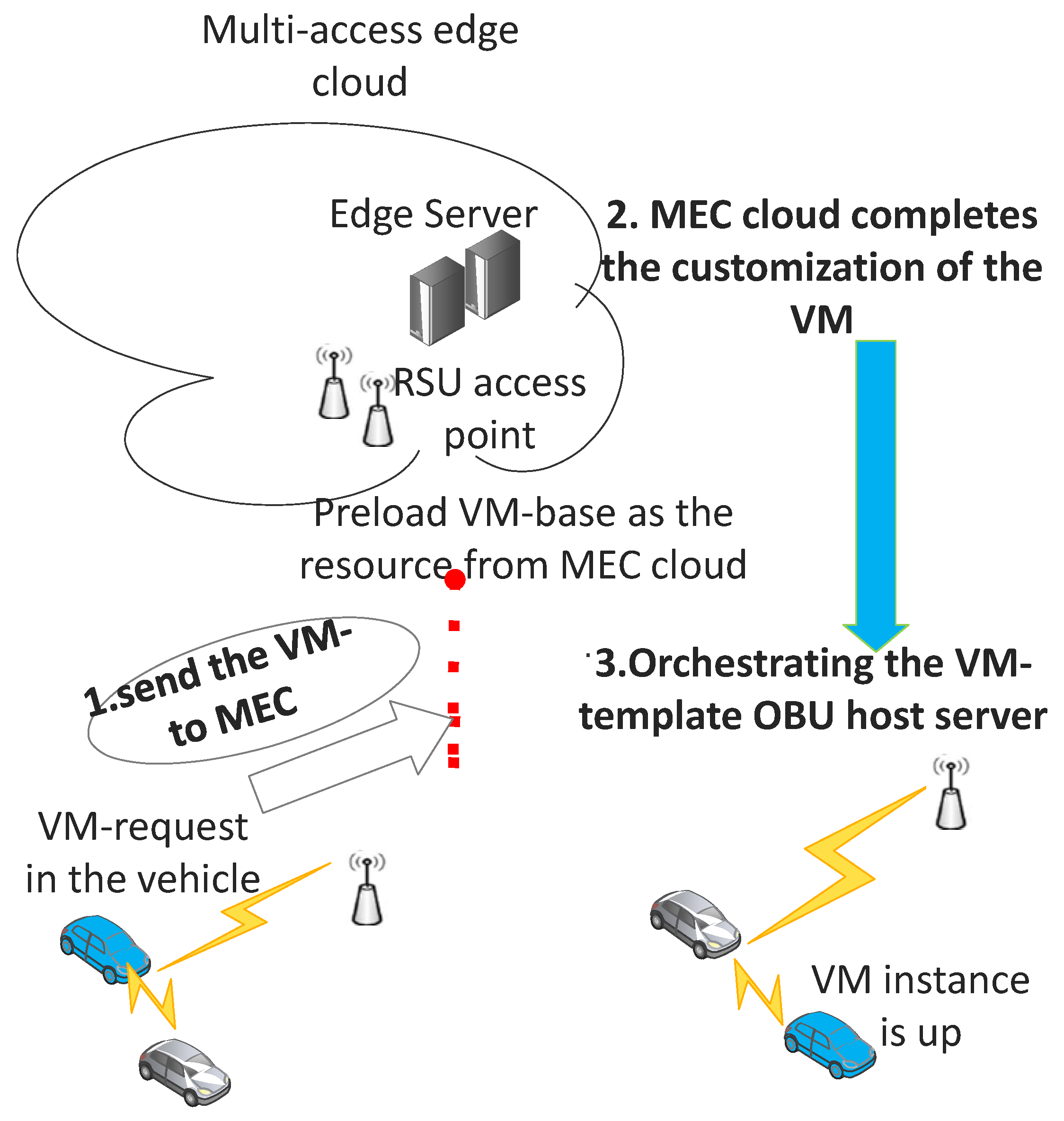
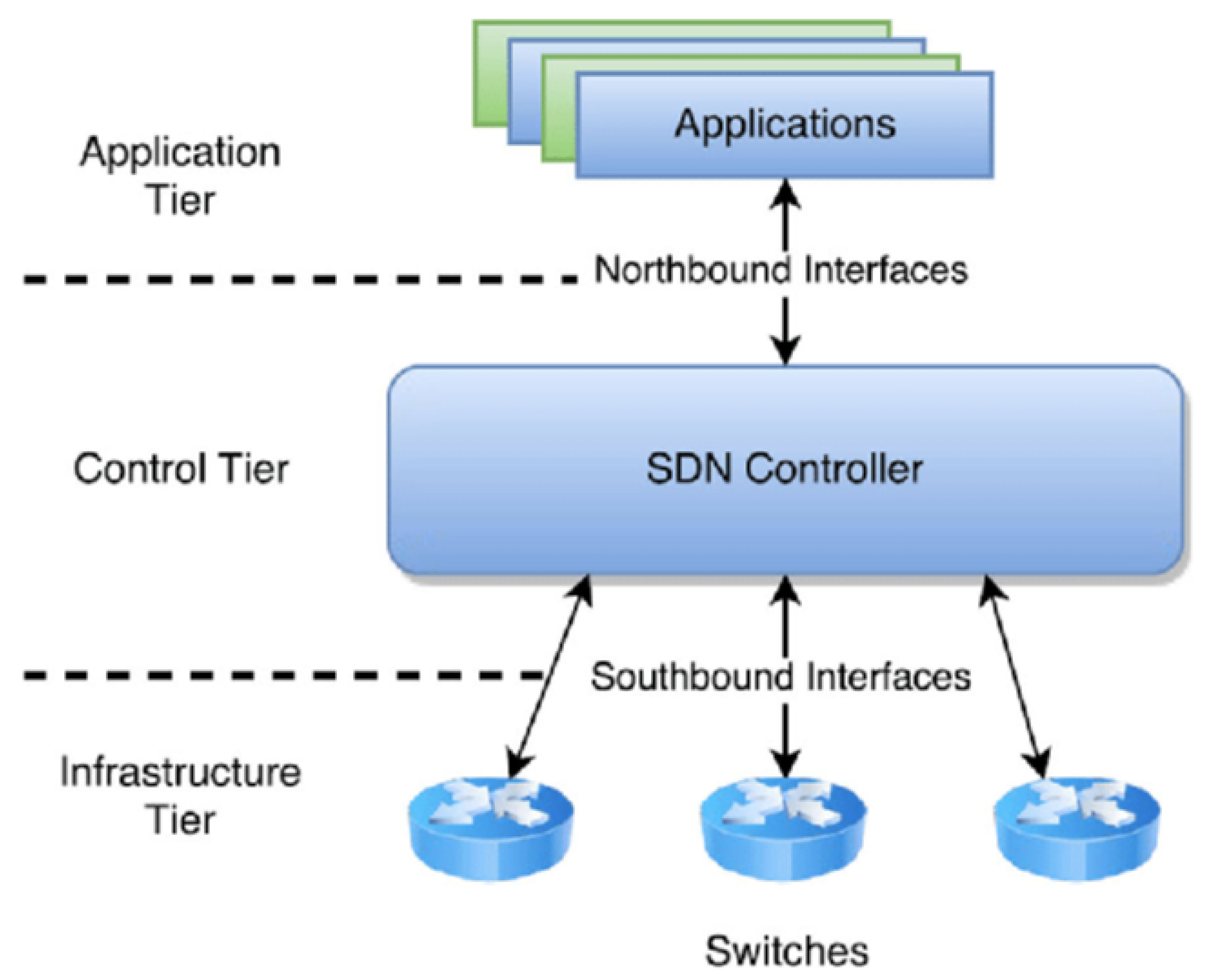

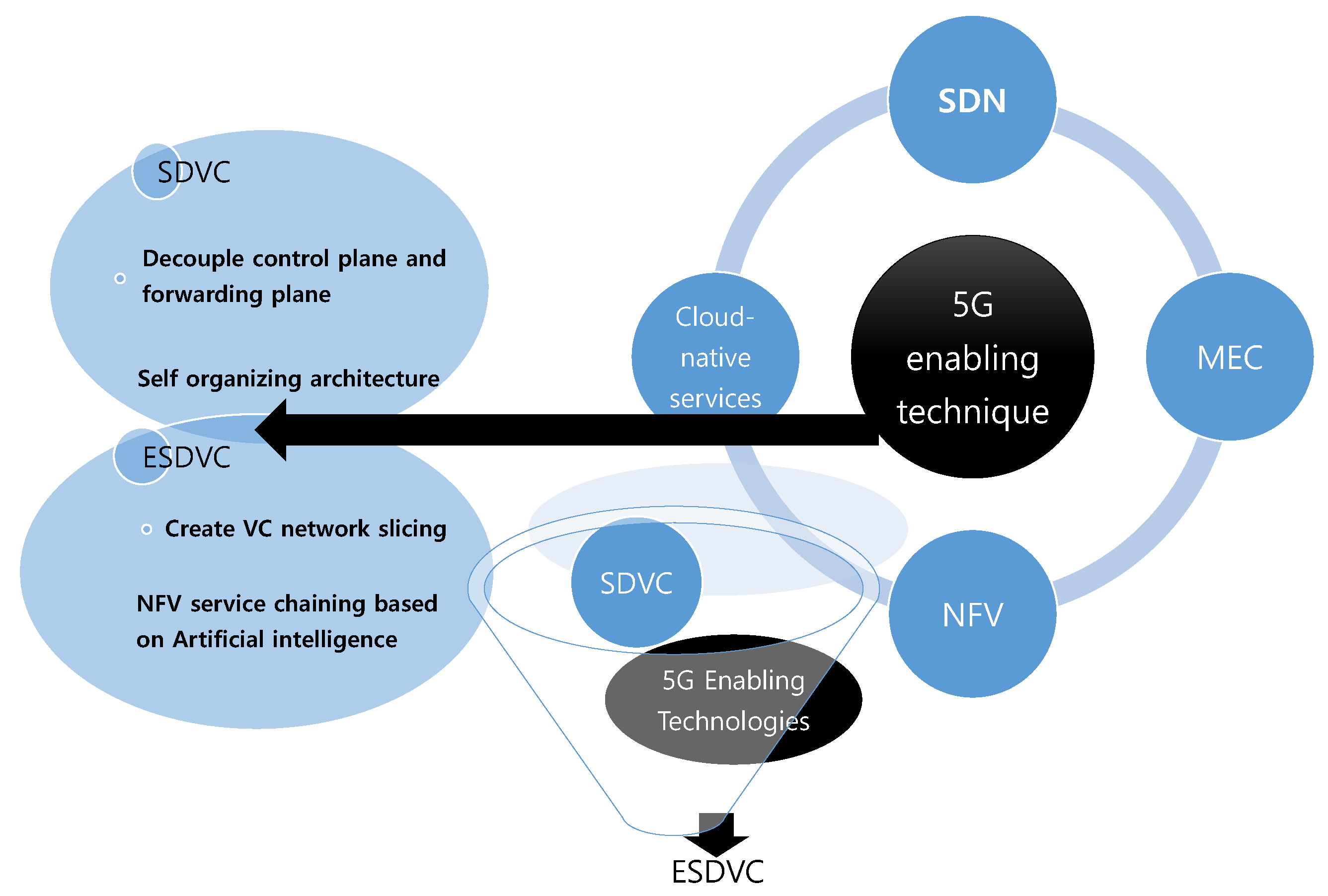
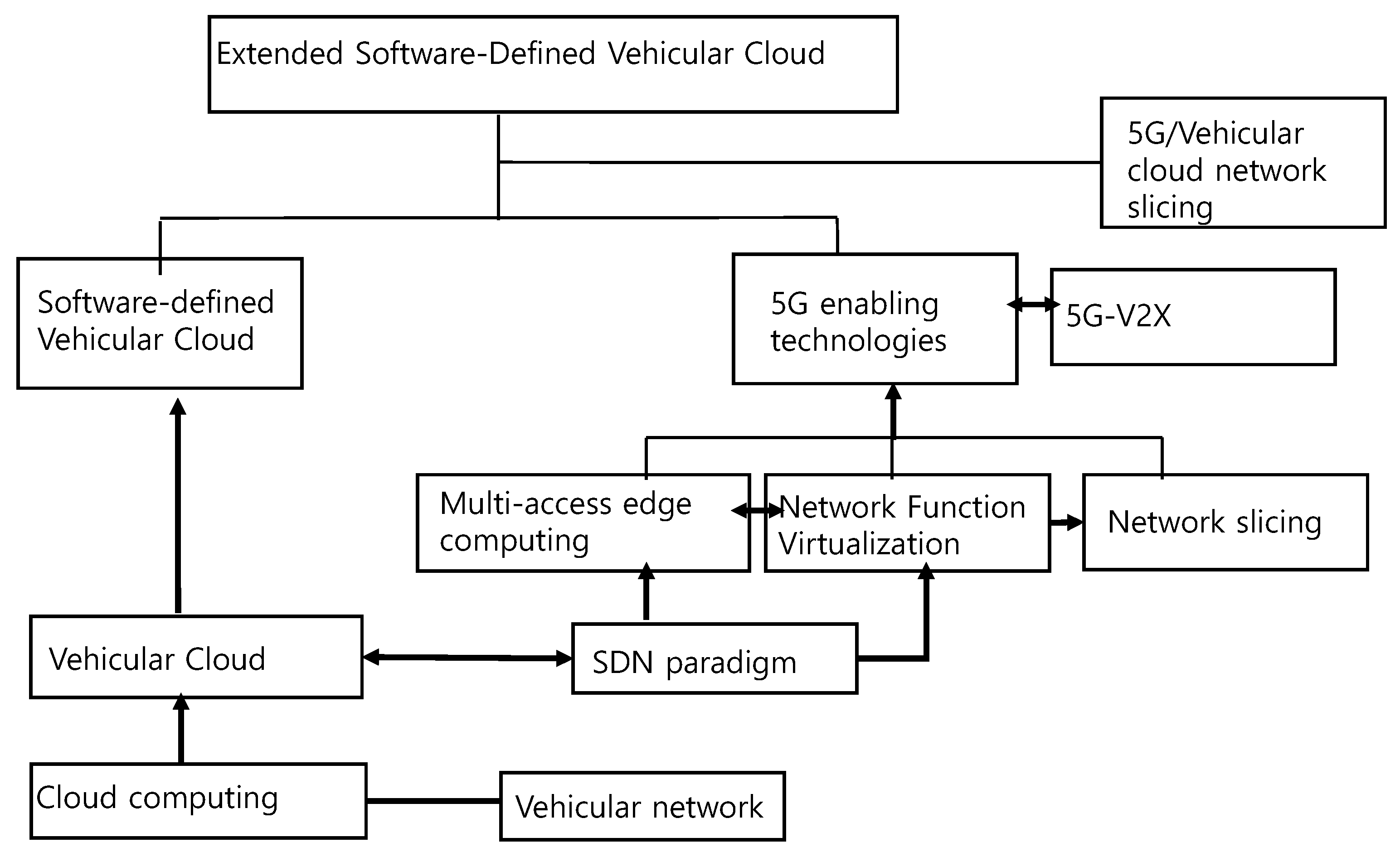
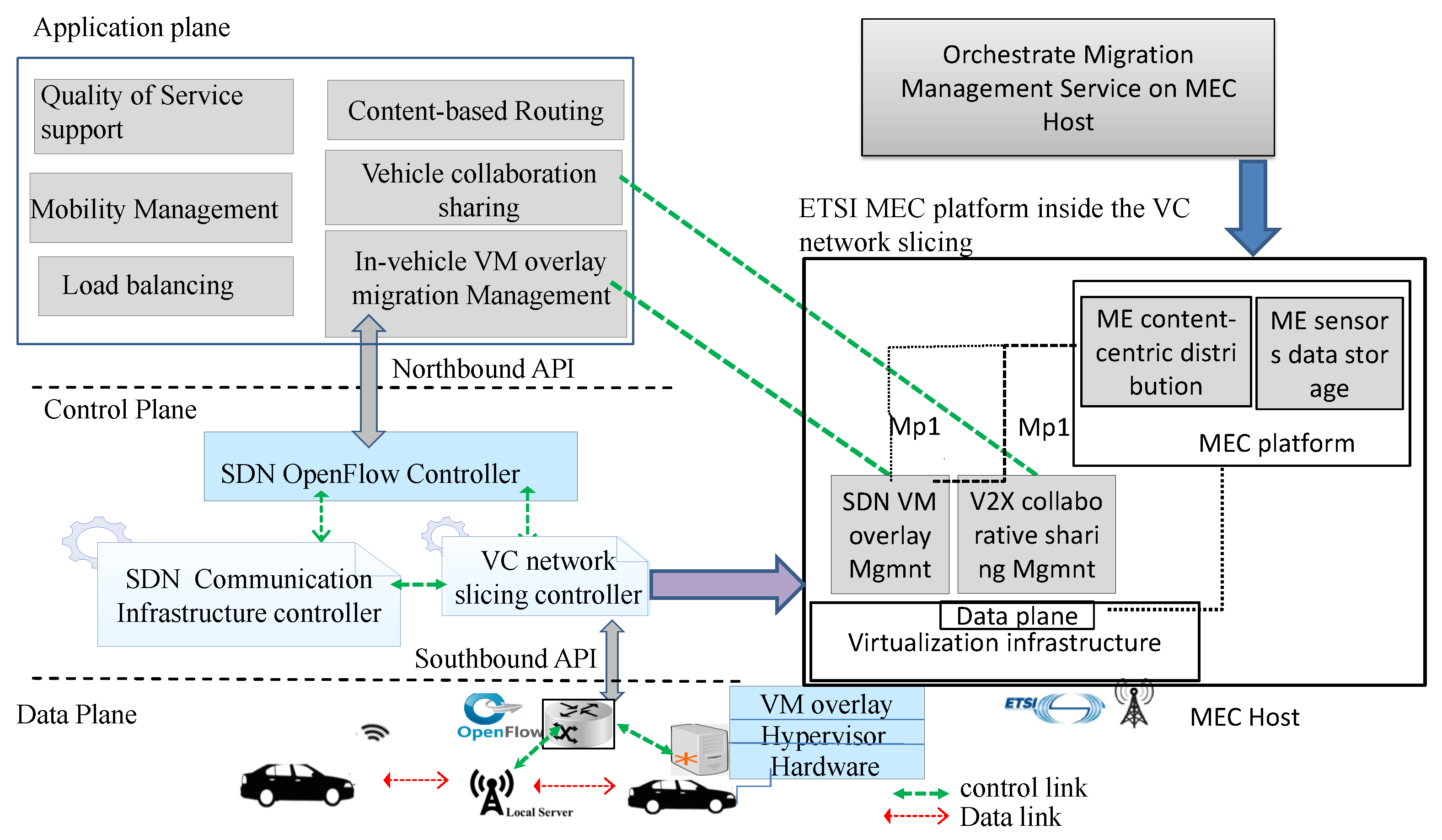



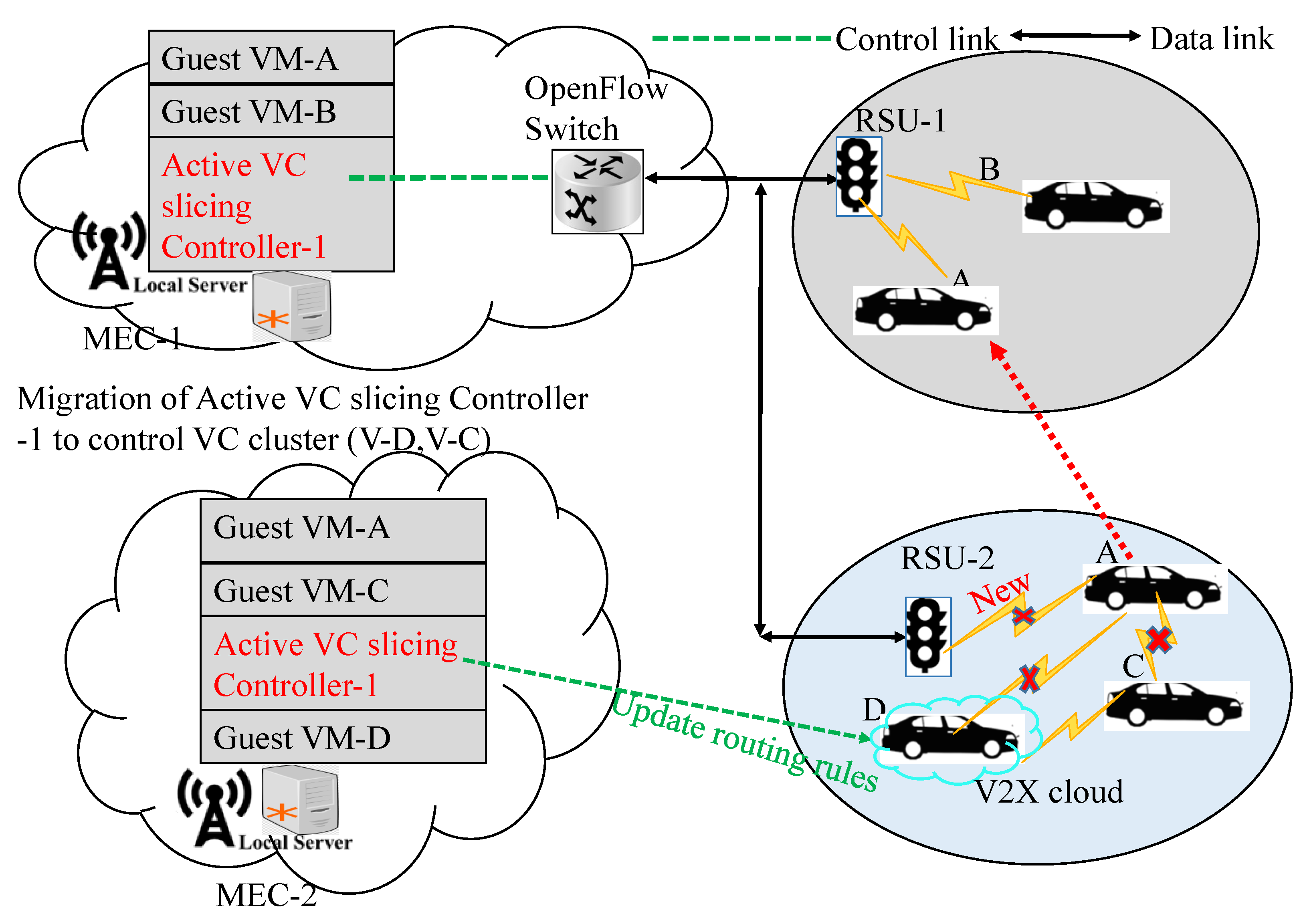

| Works | Proposed Layers | Criteria | Advantages |
|---|---|---|---|
| 2019, [36] |
|
|
|
| 2021, [35] |
|
|
|
| 2019, [38] |
|
|
|
| 2022, [39] |
|
|
|
| 2013, [33,40] |
|
|
|
| Challenge | Ref and Year | Architecture | System Analysis |
|---|---|---|---|
| Latency | [44], 2019 | Vehicular networking heterogeneity of radio access technologies |
|
| [45], 2017 | Software-defined mobile edge computing |
| |
| [11], 2017 | Software-defined VANET with 5G |
| |
| [46], 2016 | Software-defined VANET with 5G |
| |
| Resource utilization | [43], 2015 | Software-defined cloud/fog network |
|
| [47], 2017 | Software-defined VANETs |
| |
| Loss of connectivity | [19], 2017 | SDVN |
|
| Heterogeneity of wireless infrastructures | [8], 2016 | SDVANETs |
|
| [48], 2014 | SDN-based routing |
|
Disclaimer/Publisher’s Note: The statements, opinions and data contained in all publications are solely those of the individual author(s) and contributor(s) and not of MDPI and/or the editor(s). MDPI and/or the editor(s) disclaim responsibility for any injury to people or property resulting from any ideas, methods, instructions or products referred to in the content. |
© 2023 by the authors. Licensee MDPI, Basel, Switzerland. This article is an open access article distributed under the terms and conditions of the Creative Commons Attribution (CC BY) license (https://creativecommons.org/licenses/by/4.0/).
Share and Cite
Nkenyereye, L.; Nkenyereye, L.; Jang, J.-W. Convergence of Software-Defined Vehicular Cloud and 5G Enabling Technologies: A Survey. Electronics 2023, 12, 2066. https://doi.org/10.3390/electronics12092066
Nkenyereye L, Nkenyereye L, Jang J-W. Convergence of Software-Defined Vehicular Cloud and 5G Enabling Technologies: A Survey. Electronics. 2023; 12(9):2066. https://doi.org/10.3390/electronics12092066
Chicago/Turabian StyleNkenyereye, Lionel, Lewis Nkenyereye, and Jong-Wook Jang. 2023. "Convergence of Software-Defined Vehicular Cloud and 5G Enabling Technologies: A Survey" Electronics 12, no. 9: 2066. https://doi.org/10.3390/electronics12092066
APA StyleNkenyereye, L., Nkenyereye, L., & Jang, J.-W. (2023). Convergence of Software-Defined Vehicular Cloud and 5G Enabling Technologies: A Survey. Electronics, 12(9), 2066. https://doi.org/10.3390/electronics12092066






